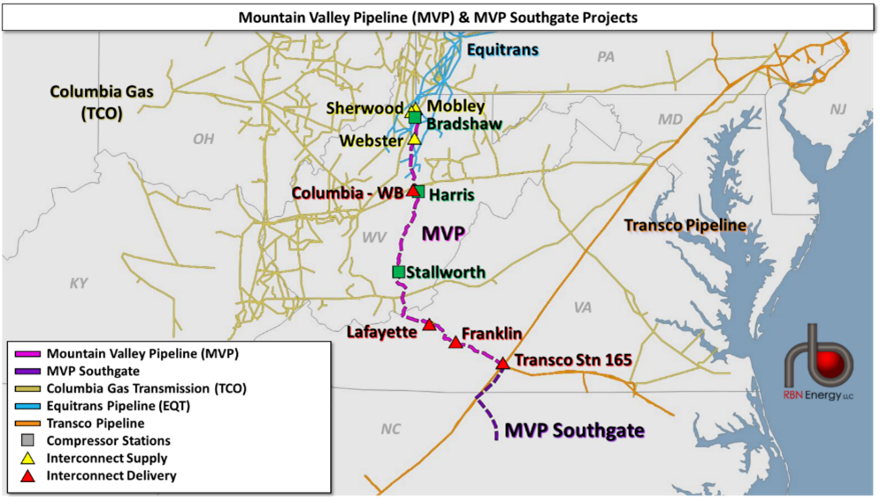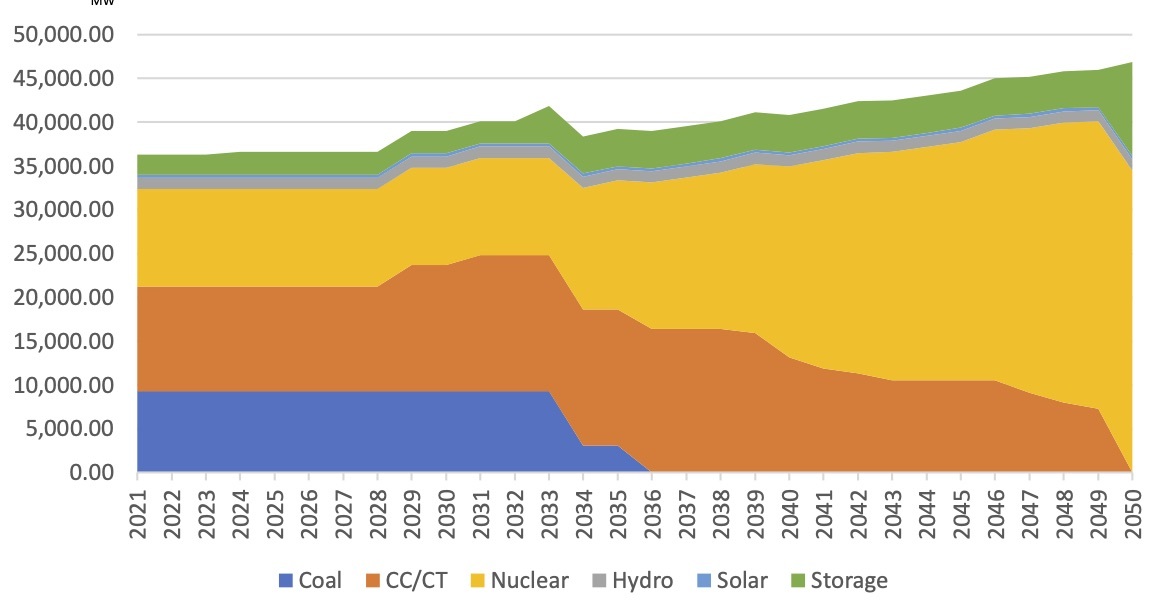- The North Carolina Utilities Commission’s initial Carbon Plan would close over 9,000 MWs of coal-fired generation by 2035
- Since North Carolina’s only interstate natural gas pipeline is fully subscribed and future supplies are so uncertain, the plan currently would add only 2,000 MWs of new natural gas generation, which wouldn’t be enough to maintain grid reliability or keep costs down
- Permitting approvals for the Mountain Valley Pipeline (MVP) under the recent debt-ceiling deal would potentially bring more natural gas into central North Carolina and give utilities access to a low-emissions baseload resource to bridge the gap between coal power and zero-emissions nuclear
This week, a News & Observer op-ed was apoplectic about the prospect of expanding natural gas into North Carolina. In a June 13 column, associate editor Ned Barnett raged that the recently passed debt-ceiling deal included permitting approvals for the Mountain Valley Pipeline (MVP), which then raised the prospect of renewing the MVP Southgate expansion into central North Carolina. [Note: Today the MVP sent a letter to the Federal Energy Regulatory Commission requesting an extension to complete the Southgate extension.]
The pipeline project is about 94 percent completed and was originally supposed to be finished by 2020, but desperate court challenges and permit delays had pushed its completion date to 2026. Meanwhile, North Carolina has a deficit of pipeline capacity and its current — and only — interstate pipeline, Transco, is fully subscribed.
Map of the proposed Mountain Valley Pipeline from West Virginia into Virginia and MVP Southgate extension into North Carolina

Source: Twitter
The prospect of a new pipeline bringing new natural gas supplies “is bad news for North Carolina’s environment and the state’s efforts to slow climate change,” Barnett stated. He concluded by hoping that, if the pipeline extension into North Carolina were built, that it would be “pulled down by protectors of the environment and the weight of its own folly.”
It’s a strange take because, as will be discussed below, if one desires to see emissions from electricity in North Carolina to fall even faster than they already are, North Carolina absolutely needs access to more natural gas. Yes, “fall even faster than they already are” — even though media habitually fail to report it, North Carolina’s carbon dioxide emissions from electricity have been cut nearly in half since 2005.
1. The Carbon Plan would close all coal plants — one-fourth of North Carolina’s generation capacity
The initial “Carbon Plan” for future electricity generation in North Carolina that was approved by the North Carolina Utilities Commission (NCUC) aims to retire all of North Carolina’s coal-fired electricity generation by 2035. It would remove over 9,000 megawatts (MWs) of power generation, which is one-fourth of North Carolina’s generation capacity.
Coal is a baseload generation source of electricity, which means it is an “always-on” source upon which the entire electric grid relies — every home and business — at any given moment in time. Electricity is consumed when it is produced. A baseload source is capable of producing more electricity the moment more is demanded. A source that needs the coincidence of outside events for production (such as sunshine and wind) is not.
2. Closing a baseload source necessitates replacing it with a baseload source — or suffering blackouts constantly
If you’re going to replace a baseload source, you need to replace it with something just as capable of being a baseload source. That replacement source has to be reliable. It has to be “dispatchable” — a term for a source that can be called upon at a moment’s notice to produce more when everyone on the grid suddenly demands more electricity.
Dispatchability is usually most important during temperature extremes. But when baseload generation is replaced by weather-dependent, unreliable “renewable” sources, the riskiest times for utilities no longer are hot spells and cold plunges. They’re dull, calm days. As a report from the Colorado Public Utilities Commission put it, what actually poses “the most significant threat” is “very benign or very boring weather.”
The worst that could happen would be to replace a baseload source with a fickle, weather-dependent source whose operations are completely detached from people’s needs. We would see widespread blackouts and all the hardships on families and businesses that those bring. Insult upon injury, since we’d have closed down already paid-for, reliable power plants and been forced to build expensive new, unreliable capacity, we’d be stuck paying much, much more money for much, much less electricity.
North Carolina’s electricity sources must, first and foremost, serve the needs of North Carolinians. We should not be governed as if we exist to serve the needs of a politically favored source.
3. Nuclear is the only zero-emissions baseload resource, but nuclear facilities take time to build
In our model “Least Cost Decarbonization” scenario presented to the NCUC in 2022, Locke’s Center for Food, Power, and Life (CFPL) would delay coal power closings and keep those units online till the mid-2030s, which would give enough time for new nuclear power plants to come online. Nuclear is the only zero-emissions baseload technology. This scenario would most fully uphold state law (the law behind the Carbon Plan) by meeting the law’s requirements of maintaining grid reliability and charting the least-cost path to compliance with reaching “carbon neutrality” by 2050.
Model Least Cost Decarbonization Portfolio: Total Installed Capacity by Year

Another reason given by the CFPL for this strategy is uncertainty over North Carolina’s natural gas supplies: “This approach would also minimize fuel supply risks for natural gas, which could be constrained by a lack of pipeline capacity.”
4. Accelerated baseload coal closures need natural gas as the “bridge” fuel to zero-emissions nuclear
If we are to close coal on the currently proposed schedule and still protect the grid’s all-important reliability and hold cost increases to a minimum, as called for by the law behind the Carbon Plan, then we need a low-emissions baseload source to fill the gap between coal-fired electricity and the long-term permitting and construction of zero-emissions nuclear power. That gap resource is natural gas.
The NCUC’s initial Carbon Plan acknowledged that obvious fact. The plan discussed the importance of natural gas as a “bridge to integrate more renewables and batteries” until sufficient zero-emissions resources “are available and can replace at scale what gas contributes to the system.” It’s an idea that stretches back to at least the Obama administration, with Pres. Barack Obama calling natural gas “the bridge fuel that can power our economy with less of the carbon pollution that causes climate change” in his 2014 State of the Union address.
The Carbon Plan stated that new natural gas facilities in the near term are “essential to achieving the Interim Target [70 percent reduction of CO2 emissions], while maintaining or improving reliability, and doing so along a least cost path.”
Despite declaring them “essential,” the NCUC had to nod to the present uncertainties of natural gas supplies into North Carolina. Citing the “significant uncertainty” of future access to additional natural gas resources “if the MVP is never completed or not timely completed,” the initial NCUC plan therefore limited the amount of new natural gas capacity to only 2,000 megawatts (MWs) of combined-cycle and combustion turbine generation.
Remember, the plan would shut down over 9,000 MWs of coal-fired generation.
The Carbon Plan cited Duke testimony before the NCUC to the effect that “delay of the new natural gas-fired resources would limit its ability to retire its existing coal units.” Completion of MVP, especially if followed by the MVP Southgate expansion into central North Carolina, would reduce uncertainty and delay of sufficient natural gas resources to serve as the bridge between baseload coal power and baseload, zero-emissions nuclear.
It’s vitally important. North Carolinians deserve reliable, baseload generation. North Carolina law requires it.


